Whether you’ve read about it online or heard it from real-life mom friends, co-sleeping is a controversial subject altogether. From “what is co-sleeping” to “how to make it safe” for your little bundle of joy, we’ve rounded up everything you need to know about the key to safe co sleeping in your baby’s first few months of life.
Cosleeping: A Newborn Sleeping Option to Ditch or Consider?
Whether you’re preparing for your little angel any day now or finding a crib way too large for your tiny little human, a co-sleeper might come in handy. Cosleeping is also worth considering if your postpartum body feels exhausted while picking up your baby frequently at night. Regardless of what the reason might be, what’s the difference between co-sleeping and bedsharing?
Well, the American Academy of Pediatrics (AAP) strongly discourages bed-sharing with infants or babies younger than one-year-old. From throwing light on when and how to use a co-sleeper to sharing authentic guidelines on safe co sleeping with babies, this article will ensure all your doubts are cleared by the end.
What is Co-Sleeping?
Co-sleeping is a newborn sleep practice in which the infant sleeps close to the parents instead of sleeping separately in another room. A co-sleeper is a kind of cot that you can place next to your bed to keep your baby close to you. Cosleeping makes frequent feedings and night-time comforting of crying or scared infants much easier for new parents, especially in the bleary-eyed days of epic sleep deprivation.
However, co-sleeping does not imply bed-sharing and, hence, is not against the sleep safety guidelines shared by the AAP. Instead, safe co-sleeping with the baby in the same room is actually recommended by the American Academy of Pediatrics to ensure newborns sleep safely and sound close to or next to their parents.
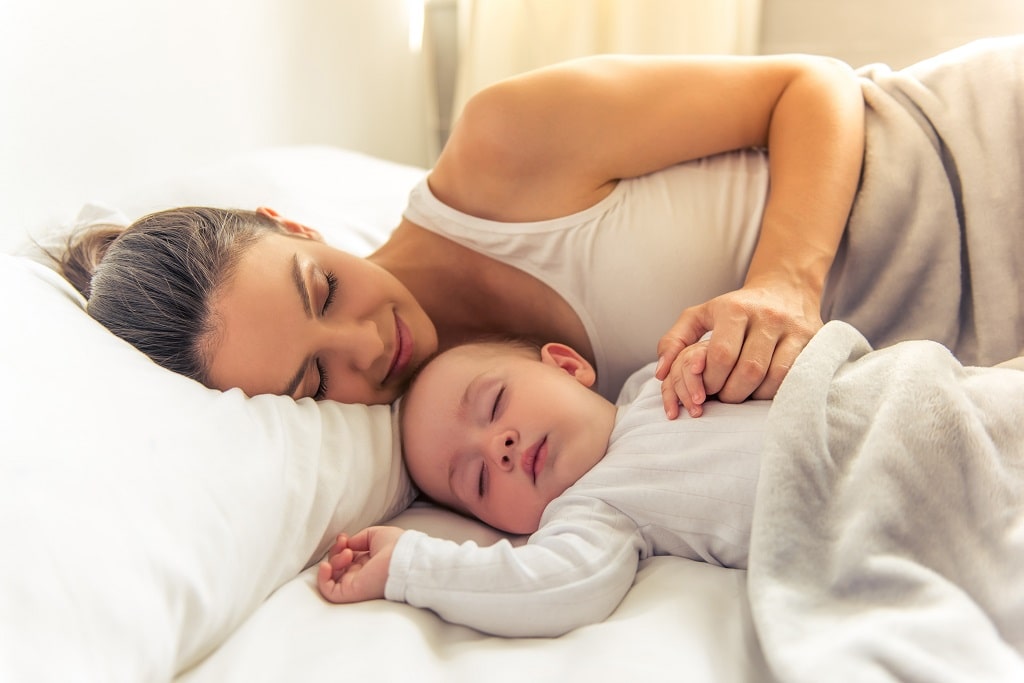
Co-sleeping vs Bed Sharing: The Unending Debate
Although both terms – cosleeping and bed-sharing are often used interchangeably, they are completely different concepts. Bed-sharing is just a way of unsafe co-sleeping and is strictly warned by the American Academy of Pediatrics (AAP). This is because it increases the risks of Sudden Infant Death Syndrome (SIDS), strangulation, and parent rollover in infants.
Many parents even search for safe bed-sharing sleep guidelines, but ultimately, there is no concept like that. Parents must never sleep in bed with their babies. Co-sleeping, on the other hand, refers to sharing a room with the baby and placing their co-sleeper close to the parents’ bed. Cosleeping is not harmful unless you share the same sleeping surface or bed.
While bedside co-sleepers near the mother are the best options, many parents who sleep in queen or king-sized beds prefer placing the cosleeper in the bed – between both parents. Some parents with a smaller bed also consider placing the cosleeper inside the crib in the same room to get easy access to the baby from their own bed.
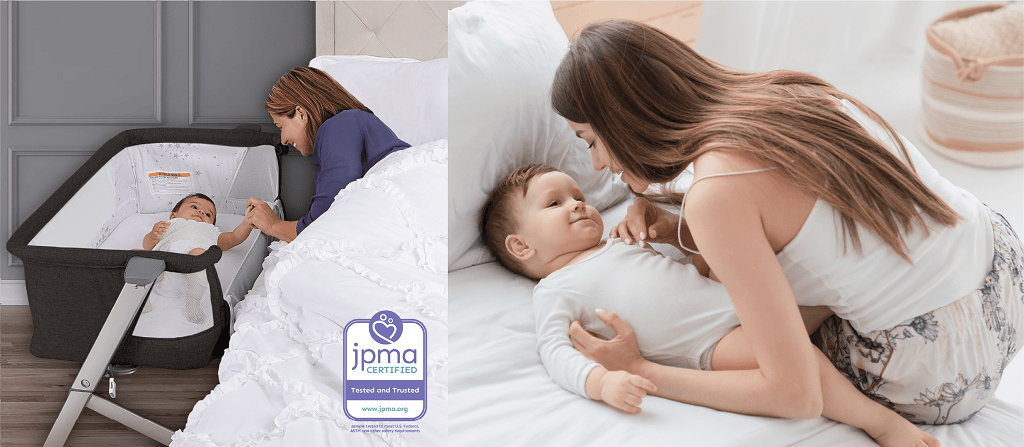
Is Co Sleeping Safe?
Okay! So, you know bed-sharing is not safe at all, but what about cosleeping? Is it safe? Why? Well, the answer is yes. Cosleeping with infant mainly refers to room sharing and is totally safe as long as you don’t share the bed and follow safe sleep practices.
- Your infant must always sleep on their back, on a firm and flat surface, without any additional blankets.
- They must always be appropriately swaddled until they are at the right age to sleep with their arms free.
- However, you must never neglect the breathability inside the co-sleeper and ensure the baby is well-ventilated with sturdy mesh walls.
- Moreover, you shouldn’t dress your baby too much because sleeping hot can pose a higher risk of SIDS.
Benefits of Co-Sleeping With Your Baby
Wondering what are the pros of sharing a room with your baby until they are big enough to be transitioned into their nursery? Here are some of the major benefits of co-sleeping with your baby without sharing the bed.
- Co-sleeping with the baby in their bedside cosleeper, bassinet, or crib right next to your bed assures you of your baby’s safety at all times.
- You could instantly check them if they get up scared or crying for their feedings.
- Moreover, co-sleeping in the same room facilitates closeness with your baby, making it easier to breastfeed, comfort your baby or change soiled diapers before your baby is really fussy to be calmed down.
- The biggest positive of cosleeping with your baby in the same room is that it can help lower the risk of SIDS by up to a whopping 50%. This is because having your baby sleeping next to you can instantly alert you if anything goes wrong or your baby encounters any breathing issues at night.
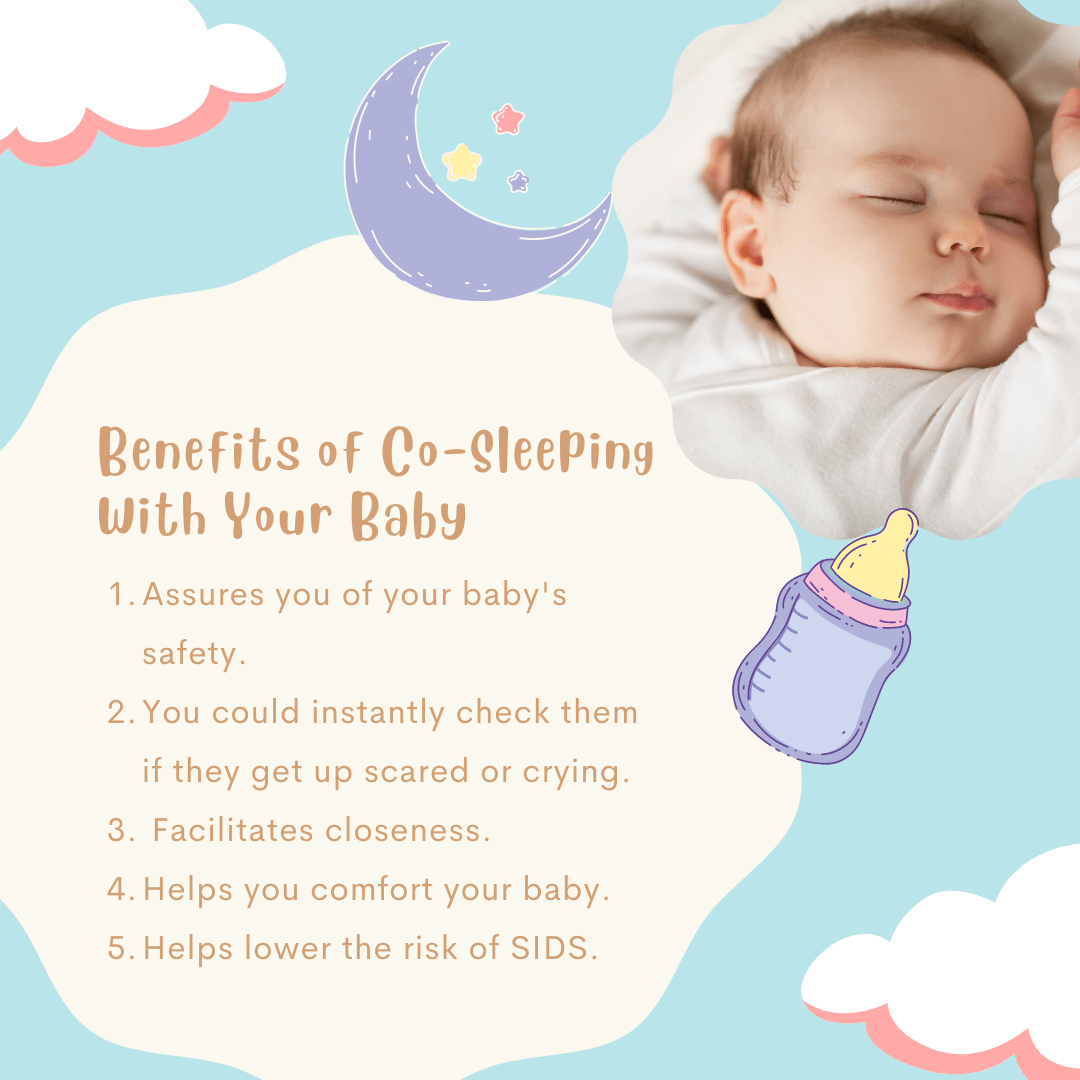
What Should You Look For In a Cosleeper?
A cosleeper is required to meet the same safety standards set forth by the CPSC and ASTM as a bassinet. However, you must ensure your cosleeper can accommodate your baby’s height and weight perfectly before they outgrow it.
Moreover, the cosleeper padding should be firm to avoid any risks of your baby getting suffocated or entrapped during the night. If you are considering a co-sleeping bassinet that can be attached to the side of your bed, always ensure there shouldn’t be any space between the bed and the baby’s cosleeper.
Myths & Truths About Co-Sleeping: Is Safe Co Sleeping Even Possible?
With co-sleeping comes countless myths that need to be busted to make parents assured of their decision. Here are some of the most popular myths you’ll hear if you want to have your newborn sleeping in bed in their co-sleeper or attach a bedside cosleeping bassinet right next to you.
Myth #1. Co-sleeping is Always Dangerous
Fact: Cosleeping is thought to be synonymous with bed-sharing – which is certainly dangerous. However, it is not “always” dangerous – if practised in the right way. Co-sleeping gets the approval of the American Academy of Pediatrics (AAP) if you put your tot to sleep in the same room without sharing the bed or place their cosleeper or bassinet right next to your bed.
Myth #2. Bed-Sharing Is Fine If You Sleep Alert
Fact: For most parents who think they are light sleepers, a tragedy is unlikely to happen to them. However, your baby’s safety is not worth even a single risk because you never know what may happen at any moment.
Why take any chance and allow the mishap to strike? After all, no parents want sleep-related fatalities, and most who encounter such tragedies say they never expected such a thing would happen to them.
Myth #3. The Statistics Related to Co-Sleeping Are Exaggerated
Fact:Many parents even doubt the statistics related to co-sleeping, thinking it is uncommon and just to warn parents. However, according to a 2013 study by NISP, there has nearly been a double rise in SIDS cases between 1993 and 2010.
Myth #4: Co-Sleeping Will Put a Damper on Your Love Life
Fact:Many parents are of the viewpoint that co-sleeping will kill the romance between them. However, your intimacy won’t be affected if you co-sleep with your baby perfectly.
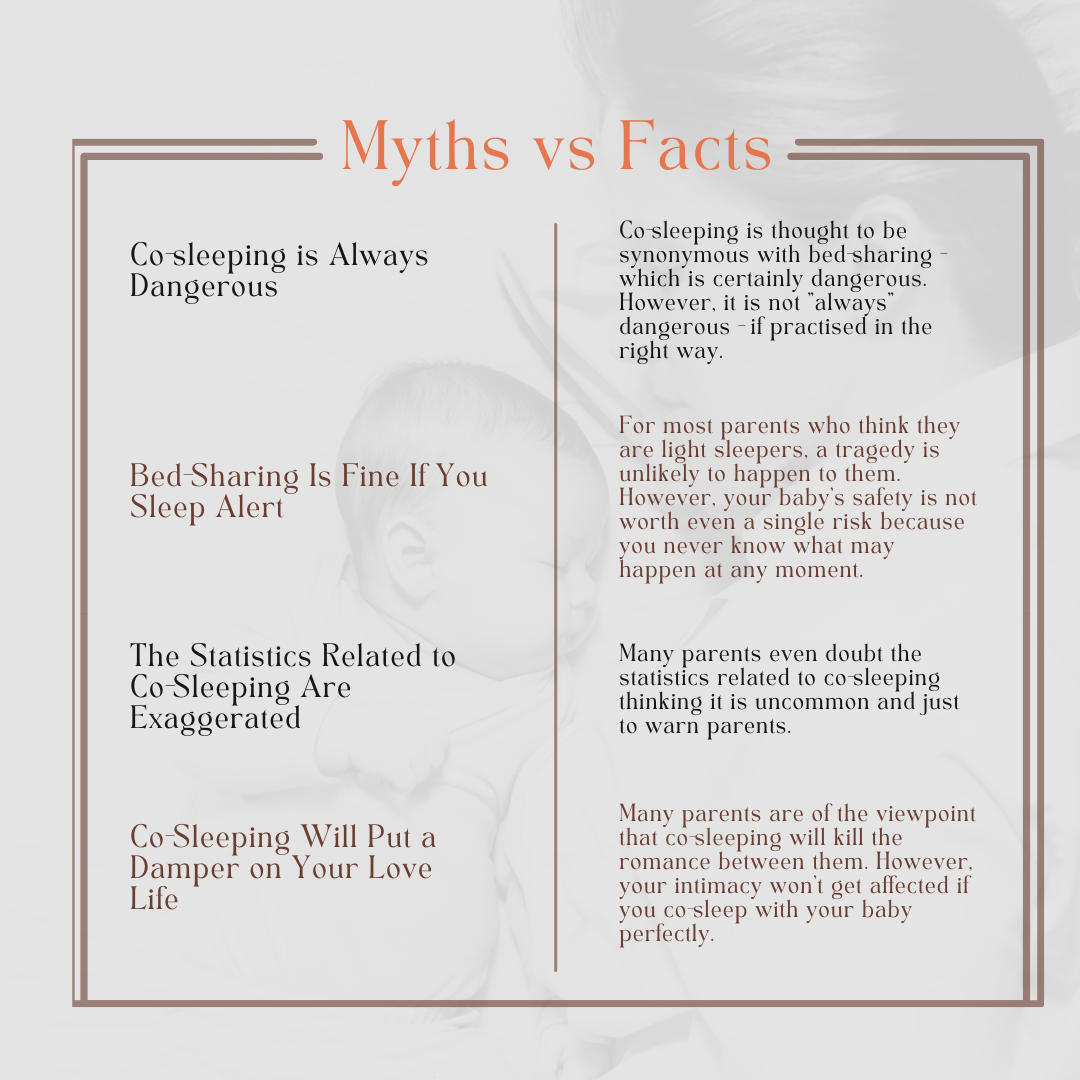
Apart from these myths, here are some truths about safe co sleeping that you might not know.
Truth #1: Co-Sleeping Can Help Reduce The Risk Of SIDS
If safe co sleeping is practised – in the same room as you but in a separate sleep space without sharing the bed or same sleep surface, co-sleeping helps put risks of SIDS away. This is because sleeping with your newborn in the same room alerts you real quick just in case there is any hazard or breathing difficulty with your baby.
Truth #2: Co-Sleeping Makes Graduation to the Crib Smoother
When you co-sleep with your baby in the same room, it helps your baby sleep fast and better throughout the night. This further makes it easier for your baby to transition from their co-sleeper or bassinet to their crib smoothly.
Truth #3: Co-Sleep Enhances the Bond Between the Parents & the Baby
Sharing your room with your baby enhances your bond with them as opposed to putting them to sleep alone in a separate room. This also helps to build a stronger bond with your baby and also enhances their overall development, including their sensory distinctions.
Steps to Make Co-Sleeping Safe for Infants: Safety Guidelines by AAP
Here are AAP’s safety guidelines to ensure safe co sleeping with your baby:
- No matter what type of co-sleeper you use, always ensure the mattress pad is firm and is away from all bedding.
- If your baby’s breathing is obstructed by blankets, sheets, or pillows, there is a higher risk of SIDS and suffocation through entrapment.
- If you are feeding your infant in an in-bed or bedside co-sleeper, place them back into their bed immediately before you accidentally fall asleep.
- If you are extremely sleepy while feeding your baby and are doubtful if you may fall asleep while feeding them, feed them in your bed instead of a couch or cushioned armchair.
- This ensures you will move the baby to their cot as soon as you wake up without any possibilities of SIDS on soft furniture or risks of your baby falling in any case.
- Whether you want an in-bed co-sleeper or a bedside bassinet with a detachable co-sleeper, use a model that is certified as per the safety standard set by ASTM and CPSC.
- It is recommended to prefer a bedside cosleeper instead of in-bedroom sharing, especially for deep-sleeping parents.
- However, if you don’t want to buy multiple sleeping options, consider investing in mini-cribs while room-sharing. These cribs are highly portable, compact enough to accommodate newborns, and can usually be converted to full-sized cribs later on.
When to Start Sleep-Training Your Baby?
Room sharing with the baby is majorly recommended for convenient feeding and comforting sessions at night. Safe co sleeping can further reduce the risks of SIDS. However, the AAP’s recommendation for cosleeping with infant in the same room is between six months and one year. So, the big question is – when should you sleep train your baby to sleep independently?
Well, most parents consider sleep training their babies to fall asleep on their own once they are at least four months old. This is also the ideal time to transition them to their crib. Although you don’t have to be too rigid in sleep training your baby and can do it even until your baby turns one, it is better to start early to minimize separation anxiety.
The rule of thumb is to let your tot sleep independently when they are developmentally ready to fall back to sleep on their own. Here are some effective ways to sleep-train your baby while room-sharing.
- Gradually start moving your baby away from your bed bit by bit so that they let go of their habit of constantly seeing you every time they wake up.
- Even if your baby resists a little, be consistent and stick to the sleep training method you are more inclined to.
- If you have been using a co-sleeper for the first few months of the baby, consider transitioning them to their crib instead of switching them to a new room and sleep space altogether.
- Follow the same bedtime routine every day and make it consistent and pleasant.
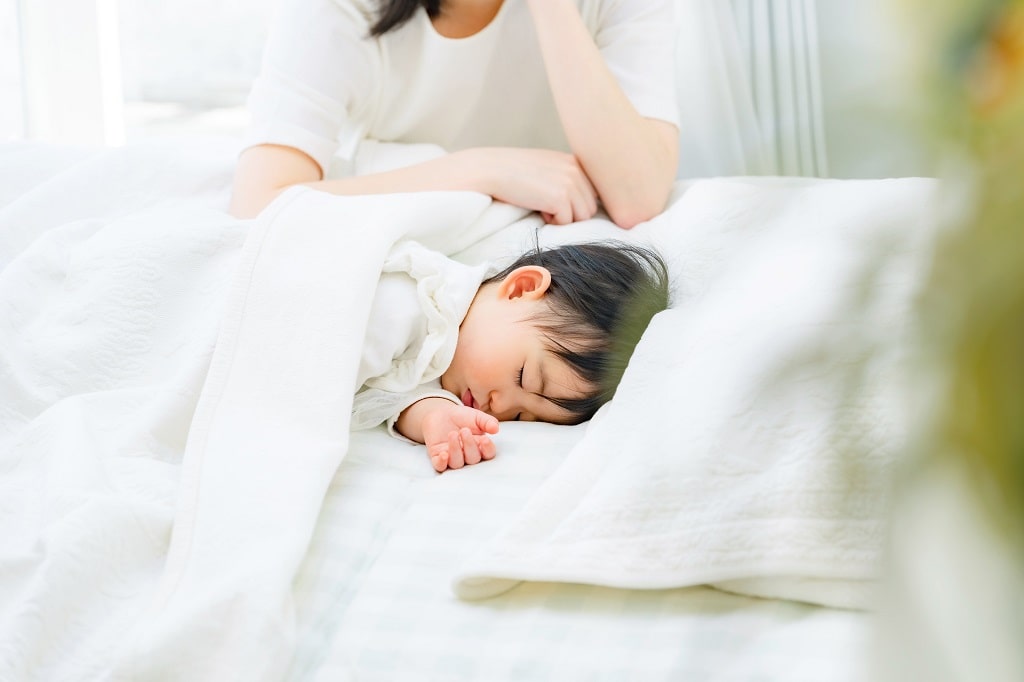
Frequently Asked Questions About Co Sleeping With Babies In The Same Room
Here are our answers to some of the most common questions about newborn sleeping in bed and using cosleeper or co sleeper for them.
What age is safe to co sleep?
Cosleeping is safe as long as you share the room and not the bed – right from birth. Although there is no strict guideline from the AAP about sleeping with babies or when to stop co-sleeping, it is better to share the room with your child from the beginning until at least six months up to a year. The risk of SIDS decreases after six months and is extremely rare when your baby turns one.
Do doctors recommend co-sleeping?
No. As soon as you practice safe co-sleeping, it is totally safe and actually advised by the American Academy of Pediatrics and doctors to sleep with your baby in the same room.
What do doctors say about co-sleeping?
Doctors do not recommend co-sleeping if you want to share the bed with your child. However, if you put them to sleep in a co-sleeper or a bedside bassinet while following all the sleep safety guidelines by the American Academy of Pediatrics, it is totally safe.
Why do babies sleep better in parents bed?
Babies can sleep better when close to their parents as they feel more safe and secure. Furthermore, if you sleep with baby at night while following all safety guidelines, it reduces the risks of SIDS and other fatalities as you can monitor your bub all through the night.
When is SIDS no longer a risk?
The risk of Sudden Infant Death Syndrome (SIDS) decreases when your baby is six months old and is not a risk anymore once your baby turns one. However, following crib sleep safety guidelines is highly crucial – even when your baby is more than one year old.
What is the safe sleep 7?
Safe sleep 7 is a series of sleep safety guidelines issued in 1999 in the book “Sweet Sleep” to make co-sleeping safer for babies. Although not evidence-based, this theory meets the CPSC safety standards and is found to be effective and reliable by most parents.
The Key Takeaway
We hope with everything we’ve covered in this article, you’ll feel more empowered to make the right choice for your baby. If you are still confused about whether to sleep with baby or not, keep on doing your research and trust your strong parental instincts.
Preparing to bring your tot into the world includes a myriad of critical decisions – one of the biggest being where and how your baby will sleep comfortably and safely. Although every parent has a different opinion when it comes to co-sleeping and room sharing, and each family has a unique lifestyle and sleep preferences, it is better to let your baby sleep near you until they are at least six months old.

